- Getting around Lijiang. Dont stay in the Old Towns more than 2 days, there is nothing to do. KRISS Oct 9, 2013 05:46
- 2013 Beijing Temple Fair BENNYLAU Feb 26, 2013 03:29
- Malaysian traveling from KUL - LAX vis Shanghai PVG ZATI_DY Jan 3, 2013 20:15
Once a Naval Secret
- Views: 11339
- |Vote: 0 0
- |Add to Favorites
- |Recommend to Friends
Have you ever wondered where the expression ‘feeling blue’ originated? Regardless of its origins, it’s easy to feel this way as the cold dead of winter steals the blue and warmth from the skies overhead. As the days turn to weeks and the weeks to months since have seen the sun through the clouds let alone the last time blue sky was visible my mind sweeps back to sweet memories of last summer.
I see myself sitting near the base of the lighthouse on the rugged northern coast of Shandong at the point that marks the boundaries of the Bohai and the Huanghai. This lighthouse sits atop the diminutive cliffs of Tianhengshan overlooking a calm azure sea beneath a clear blue cloudless sky. Blues so intense they draw me into their depths. I think of home! No surf or even a hint of a swell rolling in here but I am grateful for the sight of the sea and the many shades of blue – a sea that stretches to the horizon and a sky that is high and clear – it sooths my soul.
Looking a little like a fairytale castle, Penglai has a rather mysterious legend which is also part of her attraction. It was from here that the mythical eight immortals are said to have walked across the Bohai. Just as fascinating is the intermittent appearance of what has been considered a mirage – these sightings often resemble an island or castles and have more recently been scientifically attributed on the atmospheric conditions at the time they appear.
Penglai has another secret – or at least it was a secret once - an ancient fortified harbour and this is what I have come to see. Passenger ferries leave a new and sheltered harbour behind the headland passing to the west beneath us on their way to ports near and far. Getting here is easier than ‘walking on the water’ these days with access by speedboat, cable car or on foot as I did along the cliff top. From the beach, many take the challenging and strenuous walk along Tianheng’s ancient and rickety plank road near the base of the cliffs. From my vantage point I have a commanding 360º view overlooking this fascinating, historical site.
I am content with my vista of blues. I sit soaking up the sights and the sounds – a cool breeze evaporating the moisture from my bare skin. Penglai, once a strategic maritime and naval port is built at the waist of this large bay with the Shandong Peninsular in the south and the Korean Peninsular to the north and east. Temples and pagodas with traditional Chinese flying eaves and a mini version of the Great Wall lie amongst the colourful, rambling gardens overlooking the sea and the secreted harbour. It’s a popular summer destination, just a short one-hour drive west of Yantai on a broad six-lane highway.
The park entrance is on the waterfront just a short walk from the bus station but many of Penglai’s attractions are spread throughout the new town. An electric bus ferries visitors to and from each of the sights so be careful not to miss them. Once inside the grounds, I first tour the maritime museum where the partial hulls of unearthed ancient wooden boats of the Yuan dynasty are now preserved. It is hot and crowded so I move quickly through the rooms intrigued with the quality and content of the display. Many other artifacts have been recovered from the seabed giving clues to both the trade and daily life in the region.
Following the path from the museum I join the crowds on a footbridge and platform built across the entrance of the secret harbour. What an ingenious and safe haven for the navy of the day. It seems that everyone stops to take a photo here. Were they thinking the same thoughts as I am or just adding to their holiday snaps – I think the latter more likely. I snap a few of my own – though not of me – looking back into the harbour and once again out to sea and east along the coast to a distant six tiered tower on a small island just off shore. One of those gracefully arched bridges with eight supporting arches spans the narrow channel between the island and the shore.
The fortification wall hugs the cliff to its peak. I don’t know where the crowd has gone but it is quiet and empty here as I walk beside the wall. A beacon tower originally built during the Qing Dynasty is perched on the edge of the cliff snugly surrounded by temple pavilions some dating back to 1061. Each of these tells a story of eons past and houses the work of calligraphers, poets and philosophers. Narrow alleys wind between buildings – overgrown with shrubs and creepers they are cool and refreshingly empty of people. In centuries past these gardens must have been a delightful retreat from the otherwise harsh realities of life in this distant outpost.
Outside the fortified walls to the west a road leads up to the back of the lighthouse and the bell tower on Tianheng which overlooks both the Penglai pavilion and the meeting place of the two seas. A cable car glides quietly above the beach between the two headlands giving easy access to the point. I take my time to walk enjoying the bright and varied colours of the familiar flowering shrubs. It’s hot and sticky out of the breeze and I use my umbrella. Soon I emerge from the gardens onto the cliff top and am looking at the sea again. From here the view is stunning and I stop often to take in the scene – the sea and the sky, the bush and the flowers, those mysterious dark tiled rooftops and pagodas, the lighthouse and cliffs and that snaking wall.
A set of stairs march up before the bell tower - fully exposed to the early afternoon sun. Those of us who have made it this far take a rest in the cool sea breeze on the shady side of the building. I make myself comfortable – my back pressed against one of the red columns of the tower with the blue of sea and sky all around me. Occasionally the deep dull resonance of the chiming bell disturbs the chatter of those around me. A constant hum of religious chanting floats in on the gentle breeze. I sit a long time here and savour my surroundings, knowing that it will be many months before I see the likes of this again.
Penglai has so much to offer and not wanting to miss any of it I make my way down the back of the headland, through the gardens with their love nests and exotic flora to the Naval Museum and Imax Cinema. These are a short distance from the exit of the fort and are included in the ticket price. While I wait I’m encouraged to spend more on a ticket for the upper level of the cinema. The Naval Museum is compact and full of interesting artifacts from both land and sea and should not be missed.
From here an electric bus transports visitors several kilometers to another historical site inside the old city walls and is also included in the original ticket. While very little of the city wall remains, the Drum Tower still stands and an effort is being made to rejuvenate the surrounding area. Red lanterns line the stone flagged streets and in the evenings the place is a buzz with stands and the smell of barbequed meat and people making merry. The electric bus stops to the east of the Drum Tower in a large flagged area. It is quiet and devoid of crowds but I can hear singing close by.
Not your usual Chinese music – this is different and as I turn to take in my surroundings I spot the cross on the top of the old church building next to the square. I make my way around to a gate off the main street and ask if I can take a look inside. It is Saturday afternoon and the church choir is practicing. No one seems to mind as I step inside almost falling into the huge open baptismal font as I entered through the side door near the pulpit. Welcoming smiles from the women and a handful of men greet me as I take a seat on the opposite side of the sanctuary in this old church and sit listening. None of us speak a word in either language – but more is conveyed in the silence between us than ever could be said with words.
My time in Penglai is running out and there is more to see. Away from the coast and out of the breeze it is humid and sticky. I need to keep moving. In the shadow of the Drum tower an impressive carved stone gate marks the entrance to the beautifully restored compound and former home of Qi Jiguang just inside the city wall and includes a small museum displaying military equipment. A well-educated man of peace schooled in both culture and military tactics, this Penglai native and Ming Dynasty general became a national hero for his efforts in protecting the nation from Japanese pirates.
As one of the privileged in China he certainly lived with style, beauty and grace – each of the small walled gardens served a different purpose – one for writing, for walking, for quiet contemplation, for tending exotic plants and fruit trees, a household garden by the kitchen and the largest for general recreation with a fish pond, a small hill and covered walkways, and viewing pavilion and platforms – all offering a very self contained life within these compound walls.
Another short trip in the electric bus returns me once again to the entrance of the park, from where it is a pleasant walk along the beach. Penglai is hosting an ‘Ode to Peace’ – the International Youngsters Cultural and Artistic Ceremony with a huge display of children’s artwork arrayed along the beach esplanade. The beach is not crowded, with few people in swimming and off shore a small group of windsurfers challenges a light afternoon breeze around their triangular course. Across the street behind the beachside park is what remains of a temple, which had its upper level blown off during one of many maritime confrontations.
I take my leave in the late afternoon as workers prepare the beachside stadium for tonight’s finale of the ‘Ode to Peace’. Despite the crowds Penglai has offered me some much needed peace and restorative vistas of both sea and sky. I’ll take away some magic memories and return one day when I am ‘feeling blue’.




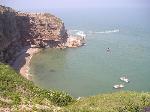
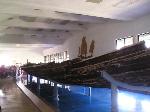
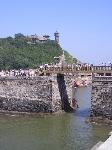
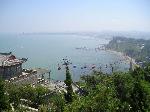
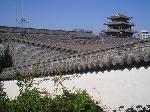

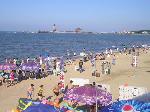

 Copyright © 1998-2025 All rights reserved.
Copyright © 1998-2025 All rights reserved.